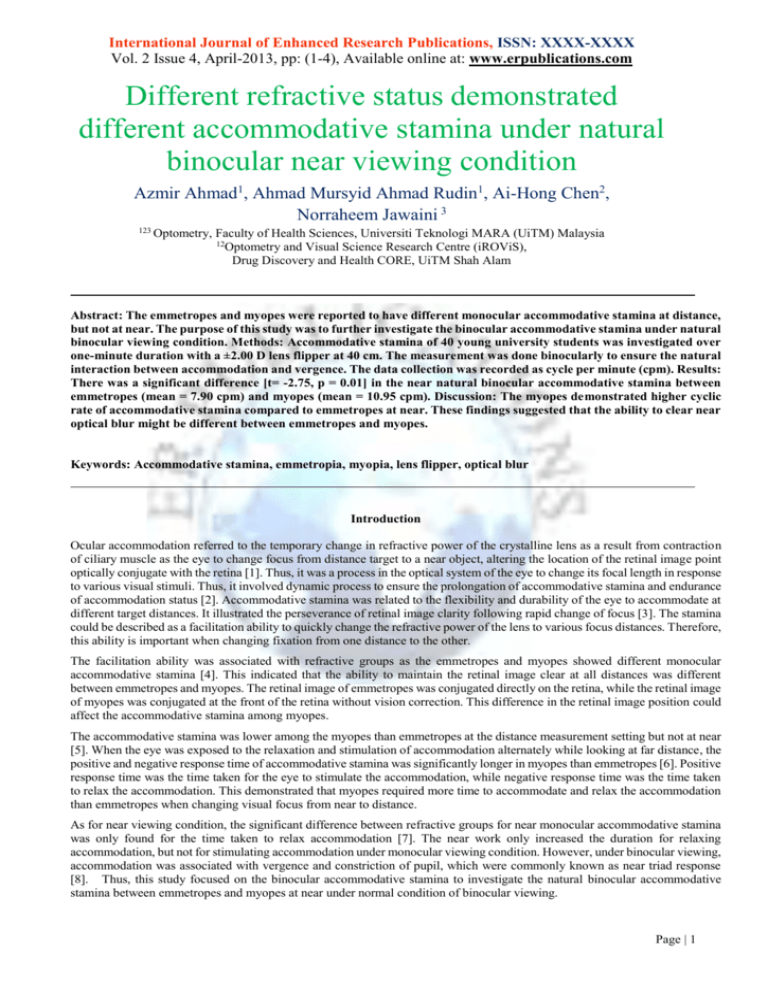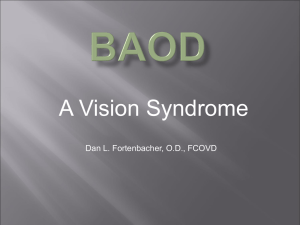Paper Title (use style: paper title)
advertisement

International Journal of Enhanced Research Publications, ISSN: XXXX-XXXX Vol. 2 Issue 4, April-2013, pp: (1-4), Available online at: www.erpublications.com Different refractive status demonstrated different accommodative stamina under natural binocular near viewing condition Azmir Ahmad1, Ahmad Mursyid Ahmad Rudin1, Ai-Hong Chen2, Norraheem Jawaini 3 123 Optometry, Faculty of Health Sciences, Universiti Teknologi MARA (UiTM) Malaysia 12 Optometry and Visual Science Research Centre (iROViS), Drug Discovery and Health CORE, UiTM Shah Alam Abstract: The emmetropes and myopes were reported to have different monocular accommodative stamina at distance, but not at near. The purpose of this study was to further investigate the binocular accommodative stamina under natural binocular viewing condition. Methods: Accommodative stamina of 40 young university students was investigated over one-minute duration with a ±2.00 D lens flipper at 40 cm. The measurement was done binocularly to ensure the natural interaction between accommodation and vergence. The data collection was recorded as cycle per minute (cpm). Results: There was a significant difference [t= -2.75, p = 0.01] in the near natural binocular accommodative stamina between emmetropes (mean = 7.90 cpm) and myopes (mean = 10.95 cpm). Discussion: The myopes demonstrated higher cyclic rate of accommodative stamina compared to emmetropes at near. These findings suggested that the ability to clear near optical blur might be different between emmetropes and myopes. Keywords: Accommodative stamina, emmetropia, myopia, lens flipper, optical blur Introduction Ocular accommodation referred to the temporary change in refractive power of the crystalline lens as a result from contraction of ciliary muscle as the eye to change focus from distance target to a near object, altering the location of the retinal image point optically conjugate with the retina [1]. Thus, it was a process in the optical system of the eye to change its focal length in response to various visual stimuli. Thus, it involved dynamic process to ensure the prolongation of accommodative stamina and endurance of accommodation status [2]. Accommodative stamina was related to the flexibility and durability of the eye to accommodate at different target distances. It illustrated the perseverance of retinal image clarity following rapid change of focus [3]. The stamina could be described as a facilitation ability to quickly change the refractive power of the lens to various focus distances. Therefore, this ability is important when changing fixation from one distance to the other. The facilitation ability was associated with refractive groups as the emmetropes and myopes showed different monocular accommodative stamina [4]. This indicated that the ability to maintain the retinal image clear at all distances was different between emmetropes and myopes. The retinal image of emmetropes was conjugated directly on the retina, while the retinal image of myopes was conjugated at the front of the retina without vision correction. This difference in the retinal image position could affect the accommodative stamina among myopes. The accommodative stamina was lower among the myopes than emmetropes at the distance measurement setting but not at near [5]. When the eye was exposed to the relaxation and stimulation of accommodation alternately while looking at far distance, the positive and negative response time of accommodative stamina was significantly longer in myopes than emmetropes [6]. Positive response time was the time taken for the eye to stimulate the accommodation, while negative response time was the time taken to relax the accommodation. This demonstrated that myopes required more time to accommodate and relax the accommodation than emmetropes when changing visual focus from near to distance. As for near viewing condition, the significant difference between refractive groups for near monocular accommodative stamina was only found for the time taken to relax accommodation [7]. The near work only increased the duration for relaxing accommodation, but not for stimulating accommodation under monocular viewing condition. However, under binocular viewing, accommodation was associated with vergence and constriction of pupil, which were commonly known as near triad response [8]. Thus, this study focused on the binocular accommodative stamina to investigate the natural binocular accommodative stamina between emmetropes and myopes at near under normal condition of binocular viewing. Page | 1 International Journal of Enhanced Research Publications, ISSN: XXXX-XXXX Vol. 2 Issue 4, April-2013, pp: (1-4), Available online at: www.erpublications.com Materials and Methods Forty young university students of Universiti Teknologi MARA participated in this study. All emmetropic subjects were with spherical component between -0.25 to +0.75 D and the cylindrical component less than -0.50 D while all myopic subject were with spherical component between -0.75 to -6.00 D and the cylindrical component less than -2.00 D [9]. With the best vision correction, the distance visual acuity was 6/6 based on Snellen scale and near visual acuity was N5 at 40 cm based on near reading chart. All subjects were free from any history of general, ocular health and binocular vision problem. Ethical approval was obtained from the Universiti Teknologi MARA (UiTM) and informed consent was taken prior to the study commencement. The subjects were screened for refractive error and ocular health before the accommodative stamina measurement and were first explained about the measurement procedures. Lens flipper ±2.00 DS was used to measure the accommodative stamina under normal room illumination. Lens flipper ± 2.00 D was chosen, as it was a reasonable choice for measurement demonstrated by Lorzei [10]. The ± 2.00 D lens flipper was accepted as routine clinical procedure in the assessment of accommodation. The subjects were examined under full vision correction binocularly with the correction fitted on trial frame. The lens flipper was placed over subject’s eyes while the subject fixated at the N6 word of near reading chart at viewing 40 cm distance [4]. Upon introducing the lens, blur target image was initially reported. The visual system needed to compensate for the optical blur introduced by the lens flipper to ensure that the retinal image remained accurately on the retinal area, especially the fovea. This involved series of relaxation and stimulation of accommodation. Once the target image was reported to be clear, the lens was flipped alternately. Measurement was conducted over one-minute duration and the data collection was recorded as cycle per minute (cpm). Results Parametric statistical analysis was carried out as the data was normally distributed based on the Shapiro-Wilk normality test (p>0.05). The mean age of all the subjects was 21.40 ±1.69 years old. From the 40 subjects, 20 of them were myopes and another 20 were emmetropes. Among the myopes, 9 were males and 11 were females while among the emmetropes, 6 were males and 14 were females. The mean natural binocular accommodative stamina at near in myopes and emmetropes were 10.95 cpm (±0.74) and 7.90 cpm (±0.83) respectively as illustrated in Figure 1. From the independent t-test analysis, there was a significant different in the accommodative facility between myopes and emmetropes (t=-2.75, p=0.01). Accommodative stamina (cpm) 14 12 10 8 6 4 2 0 Myopes Emmetropes Refractive error groups Figure 1: Means, standard deviation and independent t-test analysis of accommodative stamina under natural binocular near viewing condition between myopes and emmetropes Page | 2 International Journal of Enhanced Research Publications, ISSN: XXXX-XXXX Vol. 2 Issue 4, April-2013, pp: (1-4), Available online at: www.erpublications.com Conclusion The binocular accommodative stamina for myopes and emmetropes in this study was within the normative value of population, which ranged between 5 to 15 cpm for young adults (Scheiman & Wick, 2008). Thus, no abnormal accommodation stamina was found among all the subjects. The findings indicated that the myopes were having a significantly higher accommodative stamina at near than emmetropes under binocular viewing condition. Thus, these current findings were in the agreement with previous studies on the difference in accommodative stamina between myopes and emmeteropes. In both myopes and emmetropes, the near work increased the duration for relaxing accommodation only, but not for stimulating accommodation [7]. However, the myopes had shorter negative accommodation time than emmetropes at near. Thus, the myopes could relax their accommodation faster than the emmetropes, in turn showing higher capability of accommodative stamina as supported by the current study [5]. The myopes showed higher cyclic rate of natural binocular accommodative stamina when compared to emmetropes at near. This finding suggested that the ability to clear near optical blur might be different between emmetropes and myopes. As the measurement was conducted using spherical positive and negative lens flipper, it might suggest that the emmetropic group was under greater accommodative stress to clear the positive and negative lens [4]. With the positive lens, myopic blur was induced in which the retinal image was positioned on the front of retina. Minus lens, on the other hand, induced the retinal image to be located behind the retina and this caused hyperopic blur. With the changing of lenses between the plus and minus lens, there were magnification or minification effects to the image sizes resulted from changing the lens [11]. Optically, the magnification and minification effects were contributed largely by the amount of spherical diopters of the lens. The magnification and minification should be controlled by calculated the amounts of the magnification and minification induced by the minus and plus lenses [12]. With the introduction of lens and minus lens, the target image was made to be blurry so that in order to regain retinal image clarity, the eye accommodated or relaxed the accommodation accordingly. Our study concluded that there was a difference in the visual ability between emmetropes and myopes to clear near optical blur. These findings were applicable under normal binocular viewing accommodation system that had interaction with vergence as this study focused only on binocular accommodation status. Therefore, there was an indication to interpret clinical finding of accommodative stamina with great care. Acknowledgment This study was funded by E-Science Fund (06-01-01-SF0452) awarded by the Ministry of Science, Technology and Innovation of Malaysia. With their financial support and understanding, this study was made possible. References [1]. [2]. [3]. [4]. [5]. [6]. [7]. [8]. [9]. [10]. [11]. [12]. Rosenfield, M., 1997. Accommodation. The Ocular Examination. Measurement and Findings, 1st ed. Philadelphia: Saunders, 87-121. Naegels, G., 2003. Models Used to Treat and Remediate Learning Disabilities in Belgium and the Netherlands And Their Relation to Behavioral Optometry. Journal of Behavioral Optometry, 14(3): 65-70. Rowe, F., 2003. Clinical Orthoptics. Blackwell Publishing Ltd. Pandian A, Sankaridurg. P.R., Naduvilath T., O’Leary D., Sweeney D.F., Rose K., Mitchell P., 2006. Accommodative Facility in Eyes With and Without Myopia. Invest Ophthalmol Vis Sci., 47:4725–4731. O’Leary D.J., Allen. P., 2001. Facility of Accommodation in Myopia. Ophthal. Physiol. Opt., 21:352–355. O’Leary D.J., Allen. P., 2006. Accommodation functions: Co-dependency and relationship to refractive error. Vis. Research, 46(4):491–505. Jiang B.C, White J., 1999. Effect of Accommodative Adaptation on Static and Dynamic Accommodation in Emmetropia and Late-Onset Myopia. Optom Vis Sci., 76:295–302. Schachar, R.A., 2006. The Mechanism of Accommodation and Presbyopia. International Ophthalmology Clinics, 46(3): 39-61. Hazel, C., Strang, N. C., Vera-Díaz, F., 2003. Open- and closed-loop regressions compared in myopic and emmetropic subjects. Ophthal. Physiol. Opt., 23(3): 265–70. Loerzei R., Tran L., Goss D.A., 2003. Effect of Lens Power on Binocular Lens Flipper Accommodative Facility Rates. Journal of Behavioral Optometry, 14:1-7. Rosenfield M., Cohen A.S., 1996. Repeatability of clinical measurements of the amplitude of accommodation. Ophthal. Physiol. Opt., 16(3): 247-249. Kedzia B., Pieczyrak D., Tondel G., Maples W.C., 1999. Factors Affecting the Clinical Testing Of Accommodative Facility. Ophthal. Physiol. Opt., 19 (1): 12-21. Page | 3





